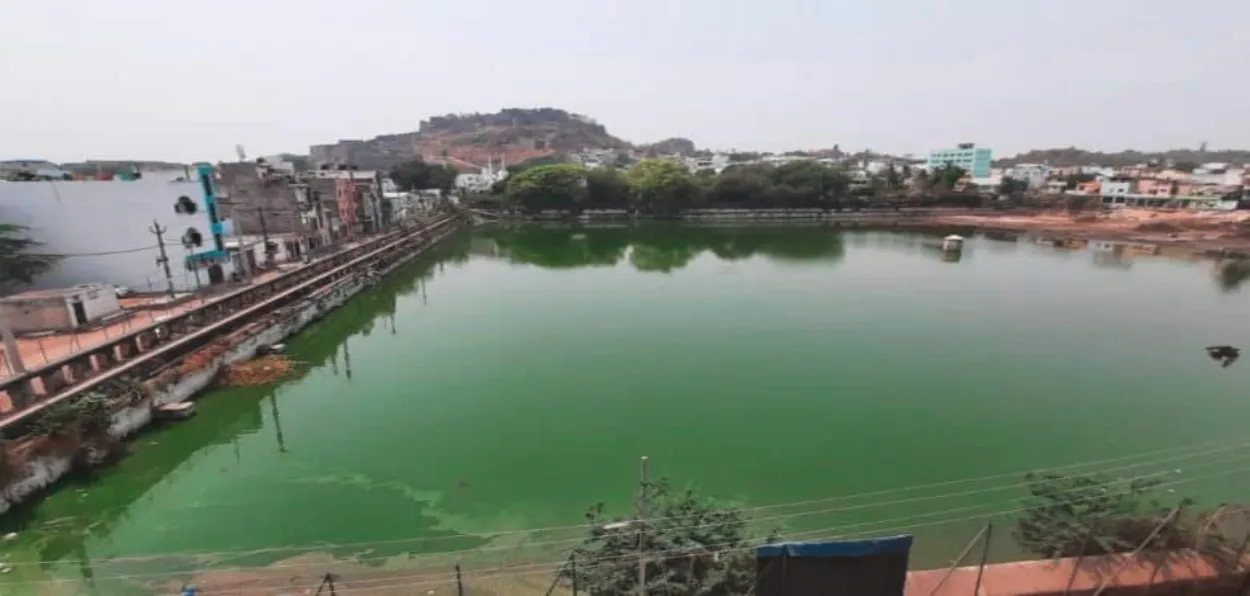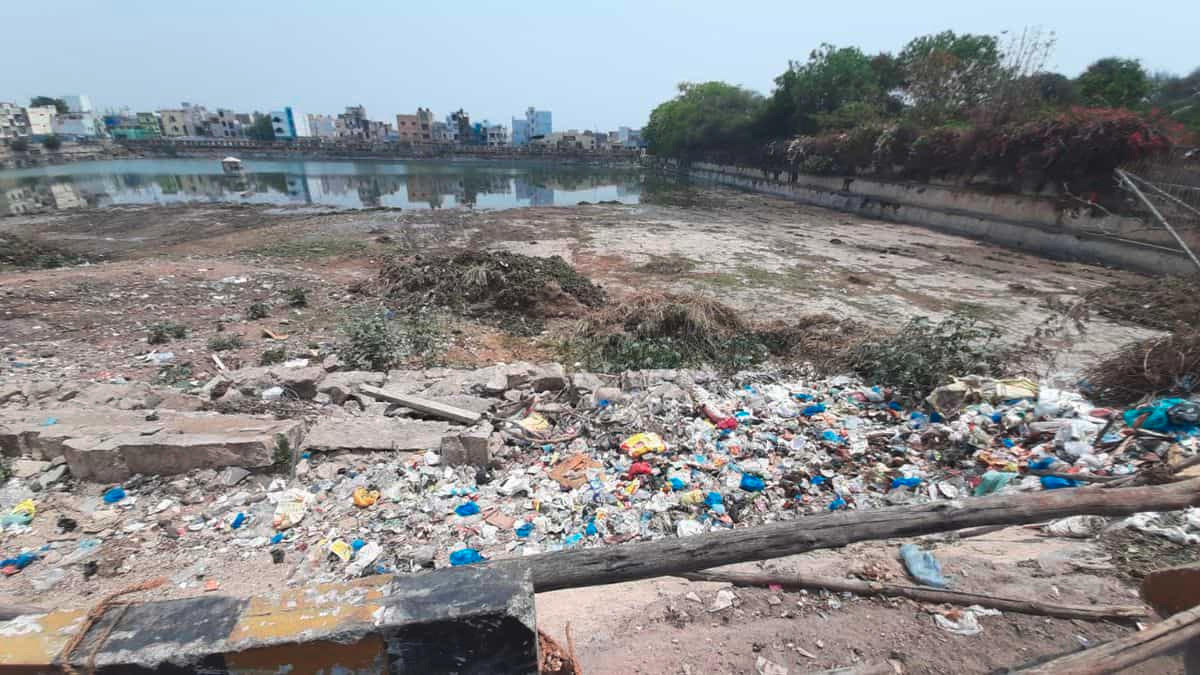
Ratna G Chotrani/Hyderabad
The heritage site of Katora Houz is in utter neglect. Flouting the heritage status of the monument, the Lake is being turned into a landfill leading to its slow death. The 460-year tank at Golconda, built by the Qutub Shahi rulers, as a freshwater storage tank resembled a septic tank.
Once the elixir for the people of Hyderabad under Qutub Shahi Kings the travelers was wowed by the Lake’s majestic view, overlooking a beautiful plateau with a perfect view of the horizon. The 5 am sun peaking through the Golconda Fort was one of the most stunning views to capture.
According to B.V. Subba Rao, an expert on Lakes, the lake is an example of historic water management of this country but sadly it is dying as garbage from the nearby residential areas is being dumped into it. The foul smell emanating from it is sickening. Although the site is protected by the Archeological Survey of India, little is being done to preserve it.
Subba Rao is also a technical member of the Water Domain Bureau of Indian Standards, Technical Advisor Water Institute Bengaluru University.
He says that Katora Houz is a four-acre perfectly symmetrical man-made lake. This reservoir was filled with water from the Talab-e –Durg (now Durgam Cheruvu). The name Katora Houze (Cup Cistern) reflects the ambitious propensities of its builders. The Houz is 10 feet deep and is bordered by lime-plastered arches and staircases arranged at the height of three feet each.
A fountain is located in the center to mark the axis of the structure. It was constructed in 1560, during the reign of Ibrahim Qutab Shah (1550-80) the third of the Qutb Shah dynasty which founded Hyderabad (1591).
 Trash and garbage from the neighbourhood is killing the Katora Houz
Trash and garbage from the neighbourhood is killing the Katora Houz
Before Hyderabad was built, the Golconda fort used to be a walled city, and several lakes such as Katora Houz (Meaning fountain) were also constructed. Katora Houz is part of the Golconda Fort. The interesting fact is the Quli Qutab Shah too were far-sighted in their vision and initiated constructing water conservation projects in those days with long-term planning. The water bodies constructed near the Golconda Fort were self-reliant in so far as water management was concerned.
Apart from Katora Houz, there was Shatam Talab and outside the Fort, there was Langar Houz. The Quli Qutab Shah’s not only focused on the architecture of the fort but also on scientific aspects of water management. All along the compound wall of the Fort, there is a water conduit for safety. In case anybody falls from the Fort he will fall into the water Kalian and remain unhurt.
The water management was designed so well that they could rotate water and sanitation to the first floor of the fort –an unheard aspect in those days.
Durgam Cheruvu which filled the Katora Houz reservoir was known for its engineering marvel. There was a terracotta underground concealed water pipe from Durgam Cheruvu to the Fort. No one was aware of this secret water pipe. History goes that when Aurangzeb invaded the Fort he could not enter the fort for six months and wondered how could the people inside the Fort survive without water and ration, This was because of the concealed water pipeline which supported the food production and water requirements of the inmates of the Fort.
Today these water bodies are in a morbid state. While ASI and Tourism Department renovates only the physical structures and landscape they have never focused on the Engineering geniuses of the then water management system .”
These unique engineering marvels are our heritage and both the Constitutional and bureaucratic have failed to highlight and preserve these celebrated systems. India is full of such examples be it the Lake view palace in Udaipur there are many such fine examples of water management and conservation. India has been an agrarian economy for more than 5000 years. These water bodies have antiquity behind them. People the Constitutional members and the bureaucracy should all work together to restore them.
Subba Rao alleges that the entrance today is filled with debris, the only stand-alone structure currently standing. It is a water body protected by the ASI as it is part of the Golconda Fort.
The people living around dump garbage in the lake and the GHMC workers set the piles of garbage afire instead of cleaning them. A resident said they have complained several times but things happened.
He said that they have requested the GHMC to fence the place to restrict people from throwing garbage into the lake but no one seems to heed.
Subba Rao said that GHMC must divert sewage from the tank. He said that it is high time the lake is restored by ASI.
Subba Rao said that he and other environmentalists look forward to the restoration of the lake.
A visit to the historic tank reveals heaps of plastic bags, garbage swirling freely with the sewage water, broken fencing, and mosquitoes
Subba Rao said that ASI has not done much to proclaim its heritage status, leave alone reclaim it.
He said that in 2011 ASI initiated the de-silting of the lake and sent representations to the GHMC to organize a proper drainage system for the residential areas surrounding the tank
An ASI superintendent informed us that locals have illegally connected sewerage and stormwater drains to the tank. A few years ago ASI authorities even blocked the drains but the residents reopened the same within days.
A Comptroller and Auditor General’s report said the erstwhile state of unified Andhra Pradesh had evolved a state water policy for effective participation of users by way of mandatory development and management of water resources with the involvement of primary stakeholders but after Telangana's formation, the Lake Protection Committee has not made any effort to include the citizens as an important stakeholder in it so far.
Meanwhile, ASI officials said that they will start restoring the lake next week. The State Government has been actively involved in the restoration of many monuments, sites of heritage; lakes, etc, and now this will be one such effort. The ASI officials have said that this they will do by first restoring the steps and peripheral structure of the lake. Fencing will be put up around the lake to restrict people from dumping garbage in the water body. Once it is restored the ASI will look into cleaning part of the lake.
ALSO READ: Lithium village of Salal in J&K brimming with pride, hope and anxiety
GHMC officials meanwhile said that they will address the issue on priority.
